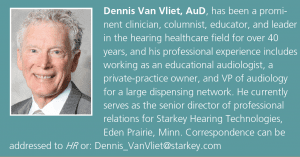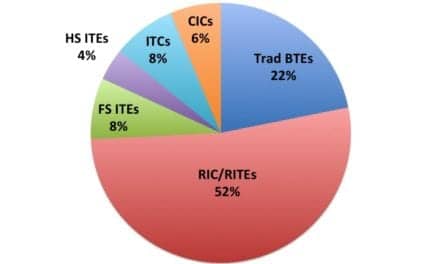Final Word | July 2017 Hearing Review
I was out on a recent Sunday morning on an errand. As I got back into the car, the radio was playing an interview in progress. I had no context for the topic, having missed the earlier conversation, but I heard the interviewer say “…that’s a hard road.” The reply I heard from actor Salma Hayek had an impact on me: “I’d rather have a hard road to excellence than an easy road to mediocrity.” At that point, the context in my brain flipped immediately to what we do daily: assessing hearing, determining needs, and developing and executing treatment plans.
As professionals, we tend to be proud of what we do and talk about quality of care and best practices. We also talk about working more efficiently, and embrace time- and labor-saving practices. As we look for more efficient and better ways of doing our jobs, I would challenge us to ask ourselves whether we are avoiding a hard road that leads to excellence, and slipping into a pathway that seems efficient but leads to mediocrity.
As we look for more efficient and better ways of doing our jobs, I would challenge us to ask ourselves whether we are avoiding a hard road that leads to excellence, and slipping into a pathway that seems efficient but leads to mediocrity.
Depending upon our work environment, we encounter choices frequently as we juggle time and workflow. Some of us may experience situations such as working in an ENT office where testing is on-demand. On-demand scheduling can create stressful situations that force compromises when several patients are waiting to be seen. Depending on the needs of the patient, and as demanded by the circumstance, we may choose to abbreviate some of the test battery, providing enough information to allow the physician to make a diagnosis and provide timely care to the patient, yet not performing all the procedures required by best practices. These clinical choices to abbreviate are defensible if good clinical care is delivered, and the patients’ time is respected. Busy clinical environments can be a hard road, but can lead to excellence by providing thoughtful care and a good experience for patients. However, if we abbreviate procedures just to get through the day quicker, I’d call it an easy road.
The discussion about verifying hearing aid fittings with objective measurements, such as real-ear to coupler difference (RECD) or probe microphone measures, is a frustrating one. There are peer-reviewed guidelines and general agreement that objective measures reflect best practice, yet the procedures are not routinely followed by a majority of practitioners, audiologists, and hearing aid specialists alike. I will not argue that objective measures are mandatory for patient satisfaction. They are not, and patients may often be helped using only patient reports as a measure of benefit. One important problem is that patients may be perfectly satisfied with a notably imperfect fitting, and may be missing the full potential benefit. The hard road in this case takes very little time, gives us objective evidence of what we are doing, and can provide the patient with confidence that we are providing excellent care.
The online forums that talk about hearing aid fitting and audiology practices are good ways for us to share information and learn from each other. I routinely see comments that refer to using receiver-in-canal domes as a routine practice rather than custom-fitted earmolds. Maybe it’s because I have been taking ear impressions and fitting hearing aids for more than 40 years, but my feeling is that using domes as a routine practice is taking an easy road. I recognize that domes can be comfortable and provide excellent outcomes in many cases. However, I feel that custom molds offer better security, comfort, and performance in many circumstances and should be considered routinely for hearing aid fittings. The hard road of providing custom-fitted products is also a good way to differentiate ourselves from online and over-the-counter sales. The hard road in this case takes about 10 minutes, can provide better outcomes, and, in my opinion, can build a better bond with the patient.
The Final Word? Calling ourselves experts in our chosen line of work comes with a responsibility to be self-aware about the decisions we make so that we provide excellence in care no matter which road we take. If we maintain the standard, the easy road is fine. If the hard road is the proper path, look forward to that journey with favorable expectations, and look back with pride in the job you have done.







